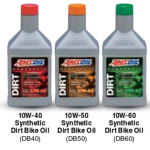Lubrication and why it’s important.
Everyone knows cars, trucks, recreation vehicles, motorcycles and more require lubrication, but not everyone understands why. A lubricant is a substance used to reduce friction between moving parts protect them from damage that can occur when they come into contact with one another. In addition to protecting equipment and reducing friction, lubricants also transfer energy, clean, cool, dampen shock and seal. Without proper lubrication, moving parts wear faster, deposits form more quickly and vehicles and equipment overheat and are more likely to break down. Some common examples of lubricants are motor oil, brake fluid, power steering fluid, transmission fluid and grease. While all motor oils are designed to lubricate, they’re not all created equal. The refining process used to create conventional lubricants separates molecules by weight, not by size or shape. The process cannot remove all of the contaminants inherent to conventional based oils including wax, which hampers conventional products’ ability to flow in cold temperatures.
The same process also allows for smaller, lighter molecules to be left behind that can boil off when exposed to high operating temperatures, resulting in a lubricant of higher viscosity. It’s thicker, harder to pump and has a reduced ability to adequately lubricate vital parts. Synthetic lubricants, on the other hand, are chemically engineered and don’t contain contaminants or molecules that don’t serve a purpose. Their pure, uniform molecular structures impart properties that provide better friction reduction, optimum fuel efficiency, maximum protection and extreme temperature performance conventional lubricants just can’t touch.

Speaking of extreme temperature performance, let’s talk about viscosity, which is a lubricant’s resistance to flow. Extreme temperatures, both hot and cold, have an effect on a lubricant’s viscosity. Low temperatures can thicken oil, impeding flow while high temperatures can thin it, causing it to break down more easily. Today’s multi-grade oils are designed to address this problem. Think of the W in viscosity listings as standing for winter. The W number indicates a lubricant’s viscosity in cold temperatures. The other larger number indicates a lubricant’s viscosity and high temperatures. So a 5W-30 offers better low temperature performance than a 10W-30, but both oils provide equal high-temperature performance. Every vehicle or piece of equipment requires a specific viscosity or grade of engine oil as indicated by the manufacturer.
A lube that’s too thick or thin can cause excess friction, heat and component wear and lost efficiency, so it’s important to follow vehicle and equipment manufacturers’ recommendations. AMSOIL has a wide selection of viscosities to give your customers’ vehicles and equipment the protection they deserve.
If you have a new gasoline car or truck use AMSOIL motor oil to ensure that you will protect your investment with the best motor oils.
For diesel applications either personal cars or trucks or fleet applications learn the proper lubrication options for diesel engines here
Use the AMSOIL look up guide to determine what AMSOI engine oil is recommended car, truck, small engine, or powersports equipment.

